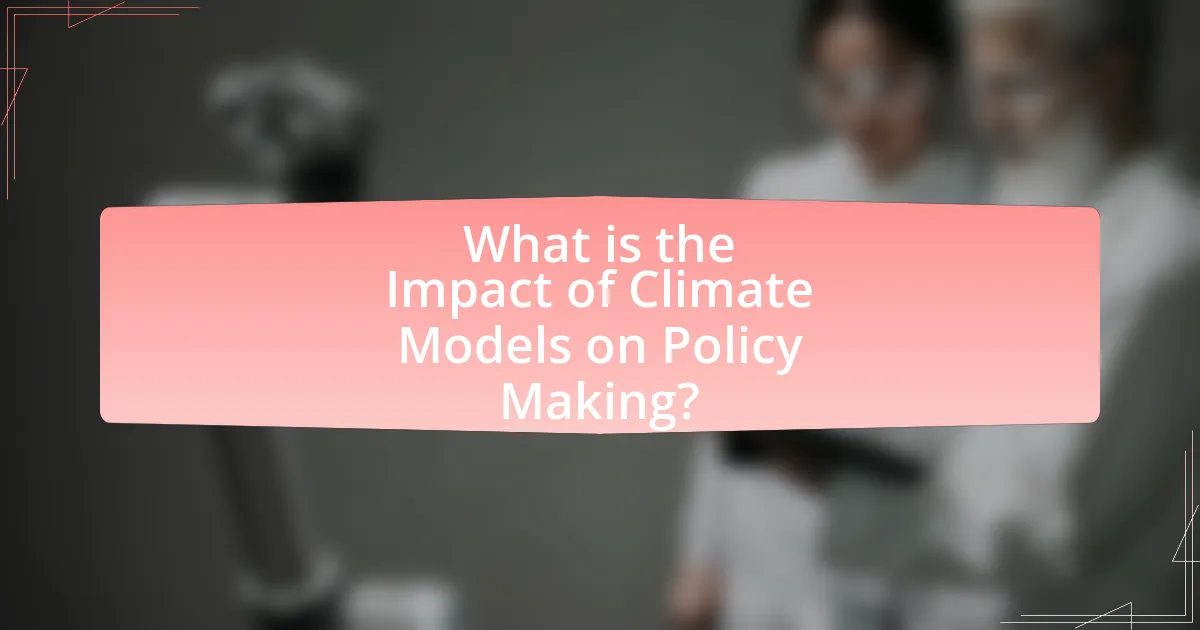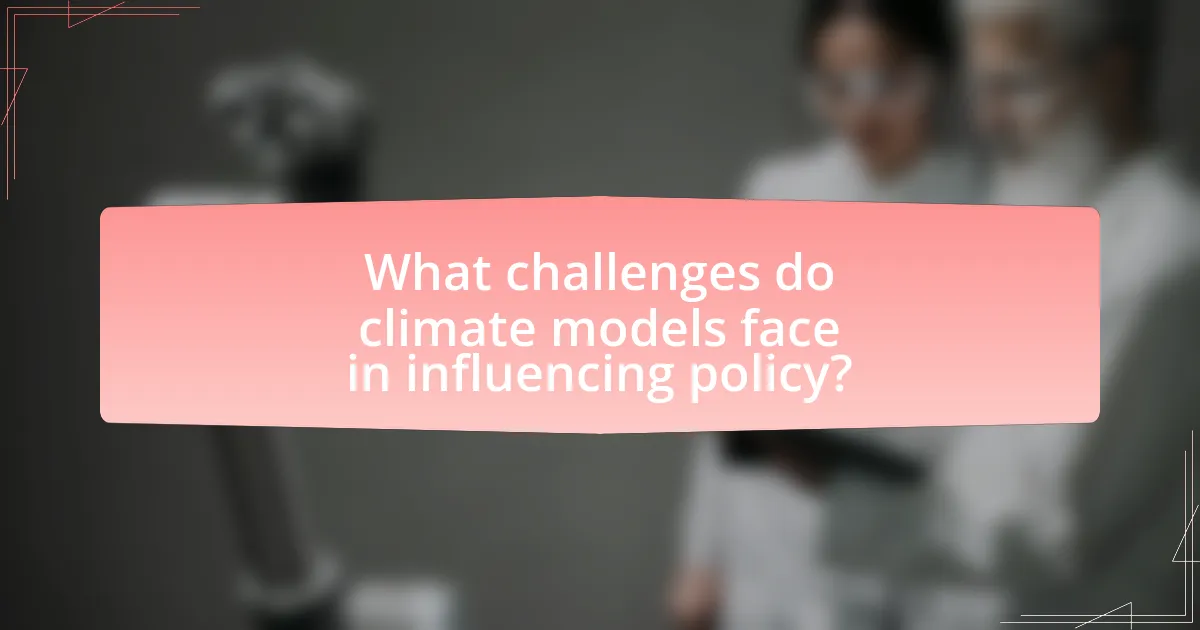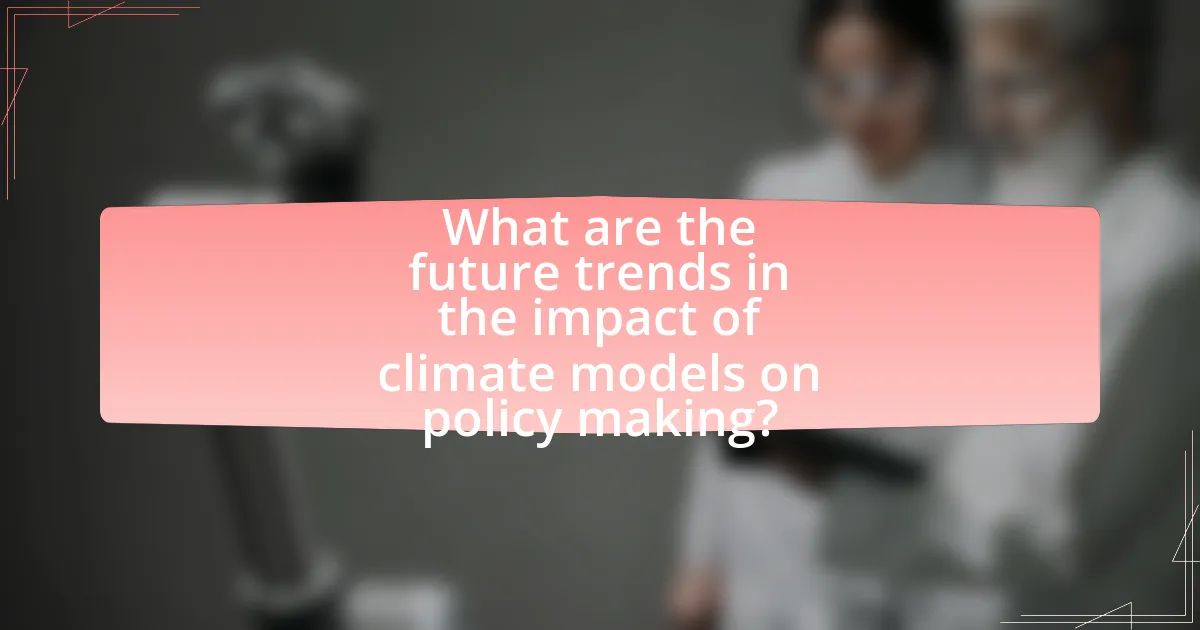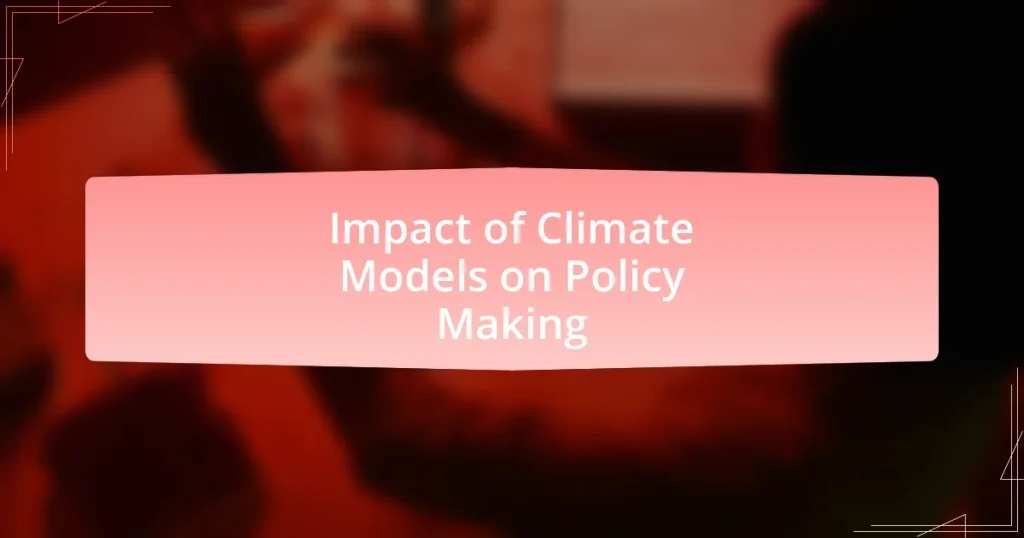The article examines the significant impact of climate models on policy making, emphasizing their role in providing data-driven projections that inform decision-making processes. It discusses various types of climate models, including general circulation models and integrated assessment models, and their utility in assessing risks related to climate change. The article highlights the importance of integrating climate model data into policy development, the challenges posed by uncertainties in these models, and the necessity of collaboration between scientists and policymakers. Additionally, it addresses the influence of political and economic factors on the application of climate models and outlines best practices for effective utilization in policy contexts.

What is the Impact of Climate Models on Policy Making?
Climate models significantly influence policy making by providing data-driven projections of future climate scenarios, which inform decision-makers about potential impacts and necessary adaptations. These models help governments and organizations assess risks related to climate change, enabling the development of effective mitigation and adaptation strategies. For instance, the Intergovernmental Panel on Climate Change (IPCC) reports utilize climate models to project temperature increases and sea-level rise, guiding international agreements like the Paris Accord. Furthermore, studies show that regions employing climate model data in their planning processes are better equipped to allocate resources and implement policies that address climate-related challenges, thereby enhancing resilience and sustainability.
How do climate models influence decision-making processes?
Climate models significantly influence decision-making processes by providing data-driven projections of future climate scenarios, which inform policy development and resource allocation. These models simulate various climate conditions based on different greenhouse gas emission trajectories, allowing policymakers to assess potential impacts on ecosystems, economies, and public health. For instance, the Intergovernmental Panel on Climate Change (IPCC) reports utilize climate models to project temperature increases and sea-level rise, guiding governments in creating adaptation and mitigation strategies. By translating complex climate data into actionable insights, climate models enable informed decisions that aim to reduce vulnerability and enhance resilience against climate change impacts.
What types of climate models are used in policy making?
Climate models used in policy making include general circulation models (GCMs), integrated assessment models (IAMs), and regional climate models (RCMs). GCMs simulate the Earth’s climate system and are essential for understanding global climate change impacts, while IAMs combine climate science with socio-economic factors to evaluate policy options. RCMs focus on specific regions, providing detailed climate projections that inform local and regional policy decisions. These models are critical for developing effective climate policies, as they provide the necessary data and projections to assess potential impacts and guide decision-making processes.
How do these models predict future climate scenarios?
Climate models predict future climate scenarios by simulating the Earth’s climate system using mathematical equations that represent physical processes. These models incorporate data on greenhouse gas emissions, land use changes, and natural phenomena to project temperature changes, precipitation patterns, and extreme weather events over various timeframes. For instance, the Coupled Model Intercomparison Project (CMIP) provides standardized protocols for climate modeling, allowing for consistent comparisons across different models and enhancing the reliability of predictions. Studies have shown that these models can accurately reproduce past climate conditions, which validates their use for future projections, thereby informing policymakers about potential climate impacts and necessary adaptation strategies.
Why is the integration of climate models essential for effective policy?
The integration of climate models is essential for effective policy because it provides data-driven insights that inform decision-making. Climate models simulate the interactions between various components of the Earth’s climate system, allowing policymakers to understand potential future scenarios and the impacts of different policy choices. For instance, the Intergovernmental Panel on Climate Change (IPCC) reports utilize integrated climate models to project temperature increases and associated risks, which guide governments in formulating strategies to mitigate climate change. This reliance on empirical data ensures that policies are not only reactive but also proactive, addressing long-term climate challenges effectively.
What are the potential consequences of ignoring climate models in policy?
Ignoring climate models in policy can lead to severe environmental, economic, and social consequences. When policymakers disregard these models, they risk underestimating the impacts of climate change, which can result in inadequate preparation for extreme weather events, rising sea levels, and biodiversity loss. For instance, the Intergovernmental Panel on Climate Change (IPCC) reports that failing to act on climate projections could lead to global temperature increases of 1.5°C to 2°C, resulting in catastrophic weather patterns and significant economic losses, estimated at hundreds of billions of dollars annually. Additionally, ignoring climate models can exacerbate social inequalities, as vulnerable populations are often the most affected by climate-related disasters. Thus, the consequences of neglecting climate models encompass not only environmental degradation but also substantial economic and social challenges.
How do climate models help in risk assessment for policy makers?
Climate models assist policy makers in risk assessment by providing data-driven projections of climate impacts, enabling informed decision-making. These models simulate various climate scenarios based on different greenhouse gas emission trajectories, allowing policy makers to evaluate potential risks such as extreme weather events, sea-level rise, and agricultural disruptions. For instance, the Intergovernmental Panel on Climate Change (IPCC) reports utilize climate models to project that global temperatures could rise by 1.5°C to 2°C by 2100 under different emission scenarios, highlighting the urgency for adaptive policies. This quantitative analysis equips policy makers with the necessary insights to prioritize resources, develop mitigation strategies, and enhance resilience against climate-related threats.
What role do stakeholders play in utilizing climate models for policy?
Stakeholders play a crucial role in utilizing climate models for policy by providing essential input, validating model outputs, and ensuring that the models address relevant societal needs. Their involvement helps to align climate modeling efforts with the priorities of communities, governments, and industries, thereby enhancing the applicability of the models in real-world decision-making. For instance, stakeholders such as local governments and environmental organizations can offer insights into specific regional vulnerabilities, which can be integrated into climate models to produce more localized and actionable data. This collaborative approach not only improves the accuracy of the models but also fosters greater acceptance and implementation of climate policies, as evidenced by initiatives like the Intergovernmental Panel on Climate Change (IPCC), which emphasizes stakeholder engagement in its assessment reports.
How do different stakeholders interpret climate model data?
Different stakeholders interpret climate model data based on their specific interests and objectives. Policymakers often focus on the implications of climate models for regulatory frameworks and economic strategies, using projections to inform decisions on emissions reductions and climate adaptation. Scientists analyze the data to understand climate dynamics and validate model accuracy, contributing to the broader scientific discourse. Businesses may interpret climate model data to assess risks and opportunities related to climate change, influencing investment strategies and operational adjustments. Environmental organizations utilize the data to advocate for stronger climate action and raise public awareness about climate risks. Each stakeholder’s interpretation is shaped by their goals, leading to diverse perspectives on the same data.
What collaborative efforts exist between scientists and policymakers?
Collaborative efforts between scientists and policymakers include the establishment of advisory committees, joint research initiatives, and the development of science-based policy frameworks. Advisory committees, such as the Intergovernmental Panel on Climate Change (IPCC), facilitate communication between scientists and policymakers by providing assessments that inform climate-related policies. Joint research initiatives, like the Climate and Clean Air Coalition, bring together scientists and government representatives to address air pollution and climate change collaboratively. Additionally, the development of science-based policy frameworks, exemplified by the Paris Agreement, relies on scientific data to guide national commitments to reduce greenhouse gas emissions. These collaborations ensure that policies are informed by the latest scientific findings, enhancing their effectiveness in addressing climate change.

What challenges do climate models face in influencing policy?
Climate models face significant challenges in influencing policy due to their inherent uncertainties and complexities. These models often rely on numerous assumptions about future emissions, climate sensitivity, and socio-economic factors, which can lead to varying predictions. For instance, the Intergovernmental Panel on Climate Change (IPCC) reports highlight that different models can produce a wide range of temperature projections, complicating policymakers’ ability to make informed decisions. Additionally, the technical nature of climate models can create a communication gap between scientists and policymakers, making it difficult for non-experts to understand the implications of model outputs. This disconnect can result in delayed or inadequate policy responses to climate change.
How do uncertainties in climate models affect policy decisions?
Uncertainties in climate models significantly affect policy decisions by creating challenges in risk assessment and resource allocation. Policymakers rely on climate models to predict future climate scenarios, but inherent uncertainties can lead to divergent interpretations of potential impacts, making it difficult to formulate effective strategies. For instance, the Intergovernmental Panel on Climate Change (IPCC) reports highlight that varying model outputs can result in different projections for sea-level rise, which directly influences coastal management policies. Consequently, these uncertainties can lead to either overly cautious approaches that may hinder economic development or insufficient action that fails to mitigate climate risks effectively.
What are the common sources of uncertainty in climate modeling?
Common sources of uncertainty in climate modeling include limitations in data quality, model structure, and parameterization. Data quality issues arise from sparse observational data and measurement errors, which can lead to inaccurate initial conditions. Model structure uncertainty stems from the simplifications and assumptions made in representing complex climate processes, such as cloud formation and ocean circulation. Parameterization uncertainty involves the choices made in quantifying processes that cannot be directly resolved by models, such as the effects of aerosols on climate. These uncertainties can significantly affect projections of future climate scenarios, influencing policy decisions based on those models.
How can policymakers address these uncertainties?
Policymakers can address uncertainties in climate models by investing in research to improve model accuracy and incorporating adaptive management strategies. Enhanced research efforts, such as the Coupled Model Intercomparison Project, provide critical data that helps refine climate projections, thereby reducing uncertainty. Additionally, adaptive management allows policymakers to implement flexible policies that can be adjusted as new information becomes available, ensuring that responses to climate change remain effective despite inherent uncertainties. This approach is supported by the Intergovernmental Panel on Climate Change, which emphasizes the importance of iterative learning and adjustment in climate policy.
What are the limitations of current climate models in policy contexts?
Current climate models face significant limitations in policy contexts, primarily due to their inherent uncertainties and assumptions. These models often rely on simplified representations of complex climate systems, which can lead to inaccurate predictions of future climate scenarios. For instance, the Intergovernmental Panel on Climate Change (IPCC) reports that uncertainties in climate sensitivity, which measures how much the Earth’s temperature will rise with increased greenhouse gas concentrations, can vary widely, impacting policy decisions based on these models. Additionally, many models struggle to accurately represent regional climate impacts, making it difficult for policymakers to implement effective localized strategies. Furthermore, the timeframes of climate models often do not align with the immediate needs of policymakers, who require actionable data for short-term decision-making. These limitations highlight the challenges of relying solely on climate models for comprehensive policy development.
How do data gaps impact the reliability of climate models?
Data gaps significantly undermine the reliability of climate models by limiting the accuracy and comprehensiveness of the simulations they produce. When essential data, such as historical climate records or current atmospheric measurements, are missing, models cannot fully capture the complexities of climate systems, leading to uncertainties in predictions. For instance, a study published in “Nature Climate Change” by Knutti and Sedláček (2012) highlights that incomplete data can result in a range of possible future climate scenarios, complicating decision-making for policymakers. This uncertainty can hinder effective climate action and adaptation strategies, as stakeholders may rely on flawed projections that do not accurately reflect potential climate impacts.
What advancements are needed to improve climate models for policy use?
Advancements needed to improve climate models for policy use include enhanced data integration, increased spatial resolution, and improved representation of climate feedback mechanisms. Enhanced data integration allows for the incorporation of diverse datasets, such as satellite observations and ground measurements, which can lead to more accurate predictions. Increased spatial resolution enables models to capture local climate variations, making them more relevant for regional policy decisions. Improved representation of climate feedback mechanisms, such as cloud formation and ocean-atmosphere interactions, is crucial for understanding the full impact of climate change. Research indicates that models with these advancements can provide more reliable projections, which are essential for effective climate policy formulation and implementation.
How do political and economic factors influence the use of climate models?
Political and economic factors significantly influence the use of climate models by shaping the priorities and funding for climate research and policy implementation. Governments often prioritize climate models that align with their political agendas, which can lead to selective use of data that supports specific policies or initiatives. For instance, countries with strong economic interests in fossil fuels may underfund or dismiss models that predict severe impacts from climate change, thereby affecting the overall accuracy and application of climate science in policy-making. Additionally, economic constraints can limit the resources available for developing and utilizing advanced climate models, impacting their effectiveness in informing policy decisions. Historical examples include the U.S. withdrawal from the Paris Agreement, which reflected political motivations that undermined the use of comprehensive climate models in favor of short-term economic gains.
What role does public perception play in climate model acceptance?
Public perception significantly influences climate model acceptance by shaping the credibility and trustworthiness of scientific findings. When the public perceives climate models as reliable and relevant, they are more likely to support policies based on these models. For instance, surveys indicate that communities with higher awareness of climate science tend to endorse climate action, as seen in the 2020 Yale Climate Opinion Maps, which show a correlation between public understanding of climate change and support for mitigation policies. This acceptance is crucial for effective policy-making, as it fosters a collaborative environment where stakeholders are willing to engage with and act upon scientific recommendations.
How can economic incentives enhance the integration of climate models in policy?
Economic incentives can enhance the integration of climate models in policy by aligning financial motivations with environmental goals, thereby encouraging policymakers to adopt and utilize these models. For instance, carbon pricing mechanisms, such as cap-and-trade systems, create a direct economic benefit for reducing greenhouse gas emissions, which incentivizes the use of climate models to forecast impacts and inform regulatory decisions. Research by the World Bank indicates that countries implementing carbon pricing have seen increased investment in renewable energy and energy efficiency, demonstrating that economic incentives can drive the adoption of climate models in policy frameworks.

What are the future trends in the impact of climate models on policy making?
Future trends indicate that climate models will increasingly influence policy making by providing more accurate and localized projections of climate impacts. Enhanced computational capabilities and advancements in data assimilation techniques will allow for more precise modeling, enabling policymakers to make informed decisions based on region-specific climate scenarios. For instance, the Intergovernmental Panel on Climate Change (IPCC) reports highlight that improved climate models can lead to better risk assessments and adaptation strategies, which are crucial for effective policy formulation. Additionally, the integration of socio-economic data with climate models will facilitate the development of comprehensive policies that address both environmental and economic challenges, as evidenced by initiatives like the European Union’s Green Deal, which relies on robust climate modeling to guide sustainable practices.
How is technology shaping the evolution of climate models for policy?
Technology is significantly shaping the evolution of climate models for policy by enhancing data collection, processing capabilities, and predictive accuracy. Advanced satellite systems, such as NASA’s Earth Observing System, provide real-time data on atmospheric conditions, land use, and ocean temperatures, which are crucial for developing more precise climate models. Additionally, machine learning algorithms are increasingly used to analyze vast datasets, allowing for improved simulations of climate scenarios and better understanding of complex climate interactions. These technological advancements enable policymakers to make informed decisions based on robust, data-driven insights, ultimately leading to more effective climate action strategies.
What innovations are being developed to enhance climate modeling accuracy?
Innovations being developed to enhance climate modeling accuracy include the integration of machine learning algorithms, improved satellite data collection, and advanced computational techniques. Machine learning algorithms analyze vast datasets to identify patterns and improve predictive capabilities, as demonstrated by research from the Massachusetts Institute of Technology, which showed a significant increase in forecasting precision. Enhanced satellite data collection, such as NASA’s Earth Observing System, provides real-time, high-resolution data that refines model inputs and outputs. Additionally, advanced computational techniques, including high-performance computing and cloud-based simulations, allow for more complex models that can simulate climate interactions at unprecedented scales, thereby increasing the reliability of climate projections used in policy-making.
How can big data and AI improve climate model applications in policy?
Big data and AI can enhance climate model applications in policy by enabling more accurate predictions and simulations of climate scenarios. These technologies process vast amounts of environmental data, allowing policymakers to understand complex climate interactions and assess the potential impacts of various policy decisions. For instance, AI algorithms can analyze historical climate data alongside socio-economic factors to forecast future climate conditions and their effects on different regions. This capability is supported by studies such as the one published in “Nature Climate Change,” which demonstrates that machine learning techniques can significantly improve the accuracy of climate projections. By integrating these advanced analytical tools, policymakers can make informed decisions that are responsive to emerging climate challenges.
What best practices can policymakers adopt for effective use of climate models?
Policymakers can adopt several best practices for effective use of climate models, including ensuring transparency in model assumptions and outputs, engaging with stakeholders, and integrating model results into decision-making processes. Transparency allows stakeholders to understand the basis of model predictions, which enhances trust and facilitates informed discussions. Engaging with stakeholders, such as scientists, community members, and industry representatives, ensures that diverse perspectives are considered, leading to more robust policy outcomes. Integrating model results into decision-making processes enables policymakers to base their strategies on scientific evidence, thereby improving the effectiveness of climate action. For instance, the Intergovernmental Panel on Climate Change (IPCC) emphasizes the importance of using climate models to inform policy by providing clear scenarios and projections that can guide long-term planning.
How can continuous education on climate models benefit policymakers?
Continuous education on climate models benefits policymakers by enhancing their understanding of climate dynamics and improving decision-making processes. This education equips policymakers with the latest scientific insights, enabling them to assess risks and develop effective strategies for climate adaptation and mitigation. For instance, a study by the National Academies of Sciences, Engineering, and Medicine highlights that informed policymakers can better allocate resources and implement policies that address climate change impacts, ultimately leading to more resilient communities.
What strategies can enhance collaboration between scientists and policymakers?
Enhancing collaboration between scientists and policymakers can be achieved through the establishment of structured communication channels. These channels facilitate regular dialogue, ensuring that scientific findings are effectively translated into policy recommendations. For instance, initiatives like the Intergovernmental Panel on Climate Change (IPCC) exemplify successful collaboration by providing policymakers with comprehensive assessments of climate science, which directly inform international climate agreements. Additionally, creating joint task forces that include both scientists and policymakers can foster mutual understanding and align research priorities with policy needs, as seen in various national climate adaptation strategies. Such strategies not only bridge the gap between scientific research and policy implementation but also promote evidence-based decision-making, ultimately leading to more effective climate action.
What are the key takeaways for policymakers regarding climate models?
Policymakers should prioritize the integration of climate models into decision-making processes to effectively address climate change. Climate models provide critical projections of future climate scenarios, enabling policymakers to assess risks and develop adaptive strategies. For instance, the Intergovernmental Panel on Climate Change (IPCC) reports highlight that without significant reductions in greenhouse gas emissions, global temperatures could rise by 1.5°C above pre-industrial levels by 2030, leading to severe environmental and economic impacts. Additionally, policymakers must recognize the importance of model uncertainty and variability, as these factors can influence the reliability of projections and the effectiveness of policies. Engaging with scientists to understand model limitations and assumptions is essential for informed policy development.


